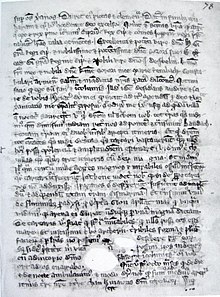Sempad the Constable

Sempad was a brother of the king of Cilician Armenia Hetoum I. He was sent by his brother to the Mongol court in Karakorum in 1247 in order to negociate an alliance. Sempad met Kublai Khan's brother Mongke Khan, and made a formal alliance in 1247 between Cilicia and the Mongols, against their common enemy the Muslims.[2] The nature of this relationship is disputed by various historians, some of whom call it an alliance, and others who say that the Armenians had submitted to Mongol overlordship, and had become a vassal state similar to any other conquered region.[3][4] Armenian and Georgian military leaders were required to serve in the Mongol army, and many of them perished in Mongol battles.[5]
Sempad, sent a letter to the Western rulers of Cyprus and the Principality of Antioch, describing a Central Asian realm of oasis with many Christians, generally of the Nestorian rite.[6] His letter was read by Louis IX of France during his 1248 stay in Cyprus, which encouraged him to send ambassadors to the Mongols, in the person of the Franciscan William of Rubruck, who went to visit the Great Khan Möngke in Mongolia.
Notes
- ^ "Le Royaume Armenien de Cilicie", p66
- ^ Bournotian, p. 100. "Smbat met Kubali's brother, Mongke Khan and in 1247, made an alliance against the Muslims"
- ^ Weatherford-181
- ^ Stewart, "Logic of Conquest", p. 8. "The Armenian king saw alliance with the Mongols -- or, more accurately, swift and peaceful subjection to them -- as the best course of action."
- ^ Bournotian-109
- ^ Jean Richard, “Histoire des Croissades”, p. 376
References
- Bournoutian, George A. (2002). A Concise History of the Armenian People: From Ancient Times to the Present. Mazda Publishers. ISBN 1568591411.
- Mutafian, Claude (1993, 2001). Le Royaume Armenien de Cilicie (in French). CNRS Editions. ISBN 2271051053.
{{cite book}}: Check date values in:|date=(help) - Richard, Jean (1996). Histoire des Croisades. Fayard. ISBN 2-213-59787-1.
- Weatherford, Jack (2004). Genghis Khan and the Making of the Modern World. Three Rivers Press. ISBN 0-609-80964-4.
